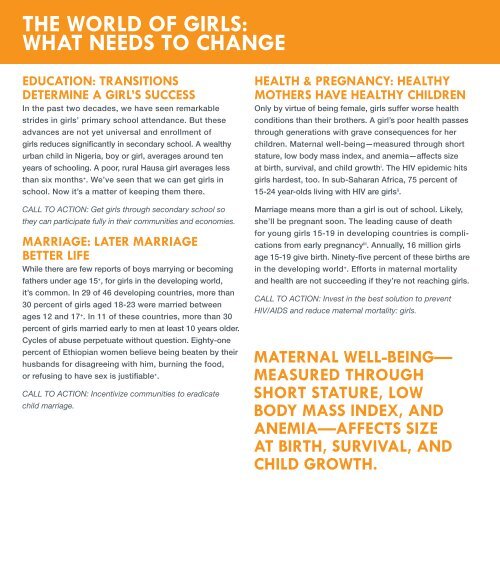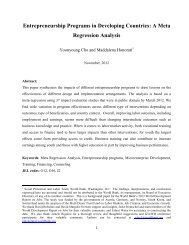SMARTER ECONOMICS: INVESTING IN GIRLS - Educate Girls
SMARTER ECONOMICS: INVESTING IN GIRLS - Educate Girls
SMARTER ECONOMICS: INVESTING IN GIRLS - Educate Girls
You also want an ePaper? Increase the reach of your titles
YUMPU automatically turns print PDFs into web optimized ePapers that Google loves.
THE WORLD OF <strong>GIRLS</strong>:<br />
WHAT NEEDS TO CHANGE<br />
EDUCATION: TRANSITIONS<br />
DETERM<strong>IN</strong>E A GIRL’S SUCCESS<br />
In the past two decades, we have seen remarkable<br />
strides in girls’ primary school attendance. But these<br />
advances are not yet universal and enrollment of<br />
<br />
urban child in Nigeria, boy or girl, averages around ten<br />
years of schooling. A poor, rural Hausa girl averages less<br />
than six months + . We’ve seen that we can get girls in<br />
school. Now it’s a matter of keeping them there.<br />
CALL TO ACTION: Get girls through secondary school so<br />
they can participate fully in their communities and economies.<br />
MARRIAGE: LATER MARRIAGE<br />
BETTER LIFE<br />
While there are few reports of boys marrying or becoming<br />
fathers under age 15 + , for girls in the developing world,<br />
it’s common. In 29 of 46 developing countries, more than<br />
30 percent of girls aged 18-23 were married between<br />
ages 12 and 17 + . In 11 of these countries, more than 30<br />
percent of girls married early to men at least 10 years older.<br />
Cycles of abuse perpetuate without question. Eighty-one<br />
percent of Ethiopian women believe being beaten by their<br />
husbands for disagreeing with him, burning the food,<br />
+ .<br />
CALL TO ACTION: Incentivize communities to eradicate<br />
child marriage.<br />
HEALTH & PREGNANCY: HEALTHY<br />
MOTHERS HAVE HEALTHY CHILDREN<br />
Only by virtue of being female, girls suffer worse health<br />
conditions than their brothers. A girl’s poor health passes<br />
through generations with grave consequences for her<br />
children. Maternal well-being—measured through short<br />
stature, low body mass index, and anemia—affects size<br />
at birth, survival, and child growth i . The HIV epidemic hits<br />
girls hardest, too. In sub-Saharan Africa, 75 percent of<br />
15-24 year-olds living with HIV are girls ii .<br />
Marriage means more than a girl is out of school. Likely,<br />
she’ll be pregnant soon. The leading cause of death<br />
for young girls 15-19 in developing countries is complications<br />
from early pregnancy iii . Annually, 16 million girls<br />
<br />
in the developing world + . Efforts in maternal mortality<br />
and health are not succeeding if they’re not reaching girls.<br />
CALL TO ACTION: Invest in the best solution to prevent<br />
HIV/AIDS and reduce maternal mortality: girls.<br />
MATERNAL WELL-BE<strong>IN</strong>G—<br />
MEASURED THROUGH<br />
SHORT STATURE, LOW<br />
BODY MASS <strong>IN</strong>DEX, AND<br />
ANEMIA—AFFECTS SIZE<br />
AT BIRTH, SURVIVAL, AND<br />
CHILD GROWTH.

















